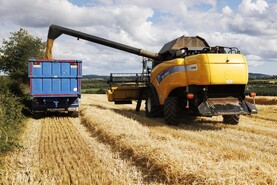The FarmPEAT project, operating for three years, gives an insight into how carbon farming measures could look for farmers on peat soils.
The project trialled results-based measures over the past three years on working farms with peaty soils in the midlands.
Although FarmPEAT was not established as a pilot for testing carbon farming, many of the actions deployed align with its aims.
Results-based payments were provided for grassland plots scored on a scale of one to 10, with payment rates ranging up to €450/ha for the best scoring parcels.
Participants received an average annual payment of €2,440 since the project began, with the highest paid farmer drawing down €11,600.
Farmers could also opt to receive a top-up payment for supporting actions which would help boost their field scores.
Raising the water table
One of these was installing dams to slow the passage of water through drains running along the boundaries of fields on peatlands, with the objective of raising the water table from 70cm from the field surface to 50cm to allow grazing to continue.
Seven of the project’s 51 farmers have put this measure in place or have committed to doing so.
“The real value of it is that for every 20cm increase in the level of the water table on a peat soil, it reduces emissions by 6t of CO2 per year which is quite a lot,” project officer Bernie Duffy said.

Farmer Tom Keane tends to his Connemara Blackface sheep with sheepdog Belle. \ David Ruffles
Voluntary adoption and on-the-ground engagement with FarmPEAT officers was key to securing buy-in to measures, according to Duffy.
“They like the flexibility. If you want to take on actions, you can. If you don’t want to, you don’t have to, but your score won’t increase and the payment won’t increase either.”
The project also used a model which had been used on deep peat rewetting projects to determine which areas would be rewet by managing drains.
The FarmPEAT project, operating for three years, gives an insight into how carbon farming measures could look for farmers on peat soils.
The project trialled results-based measures over the past three years on working farms with peaty soils in the midlands.
Although FarmPEAT was not established as a pilot for testing carbon farming, many of the actions deployed align with its aims.
Results-based payments were provided for grassland plots scored on a scale of one to 10, with payment rates ranging up to €450/ha for the best scoring parcels.
Participants received an average annual payment of €2,440 since the project began, with the highest paid farmer drawing down €11,600.
Farmers could also opt to receive a top-up payment for supporting actions which would help boost their field scores.
Raising the water table
One of these was installing dams to slow the passage of water through drains running along the boundaries of fields on peatlands, with the objective of raising the water table from 70cm from the field surface to 50cm to allow grazing to continue.
Seven of the project’s 51 farmers have put this measure in place or have committed to doing so.
“The real value of it is that for every 20cm increase in the level of the water table on a peat soil, it reduces emissions by 6t of CO2 per year which is quite a lot,” project officer Bernie Duffy said.

Farmer Tom Keane tends to his Connemara Blackface sheep with sheepdog Belle. \ David Ruffles
Voluntary adoption and on-the-ground engagement with FarmPEAT officers was key to securing buy-in to measures, according to Duffy.
“They like the flexibility. If you want to take on actions, you can. If you don’t want to, you don’t have to, but your score won’t increase and the payment won’t increase either.”
The project also used a model which had been used on deep peat rewetting projects to determine which areas would be rewet by managing drains.







 This is a subscriber-only article
This is a subscriber-only article










SHARING OPTIONS: